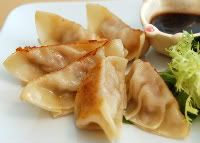
Normally, when we go out to eat in Chinese restaurants, what do we normally order? I personally go for the potstickers that are described as a fancy, looking fried dough with a meaty filing, served with soy sauce on the side. This pocket-like cuisine can also be prepared with a batter, pastry, or even leaves. It can be served with or without any designated filling. Popular fillings include Chinese cabbage, pork with celery, lamb with spring onion, or leeks with eggs. So what am I referring to? Dumplings, of course.
Although dumplings are incorporated in many British, Irish, Italian, and Scandinavian cuisines, it is one of the most common Asian cuisines that people consume. The definition derives from two categories: one sweet and one savory. The “sweet” definition is prepared with sweetened dough and filled with the fruit of your choice. Very common in the United States, dumplings are prepared as a tart with apples and are later baked to perfection. The “savory” approach is prepared with dough and minced meat and vegetable as its fillings, which is then cooked in boiling water or fried. Meats that are normally incorporated in this dish are pork, beef, shrimp and fish. However, among the variations of how dumplings are prepared, people don’t realize the significance of a typical Chinese dumpling.
Among the many assortments of dumplings, the Chinese dumplings are the most favorable. Dumplings are very important to the Chinese culture. Its history dates back in the ancient times when the Chinese first created the Jiaozi, or dumplings. The ingredients frequently used are meat and vegetable fillings and are very essential to holidays celebrated in Northern China. The Spring Festival is an important event, in which the Chinese prefer to eat dumplings to indicate their good fortunes for the New Year. Since the shape of Chinese dumplings is similar to ancient Chinese gold or silver bars, they symbolize wealth. Traditionally, the whole family gets involved when making dumplings during New Year's Eve. In most cases, they may hide coins in one of the dumplings and whoever stumbles upon it will have a good fortune in the New Year. Never hesitate to try a “lucky” dumpling.
No comments:
Post a Comment